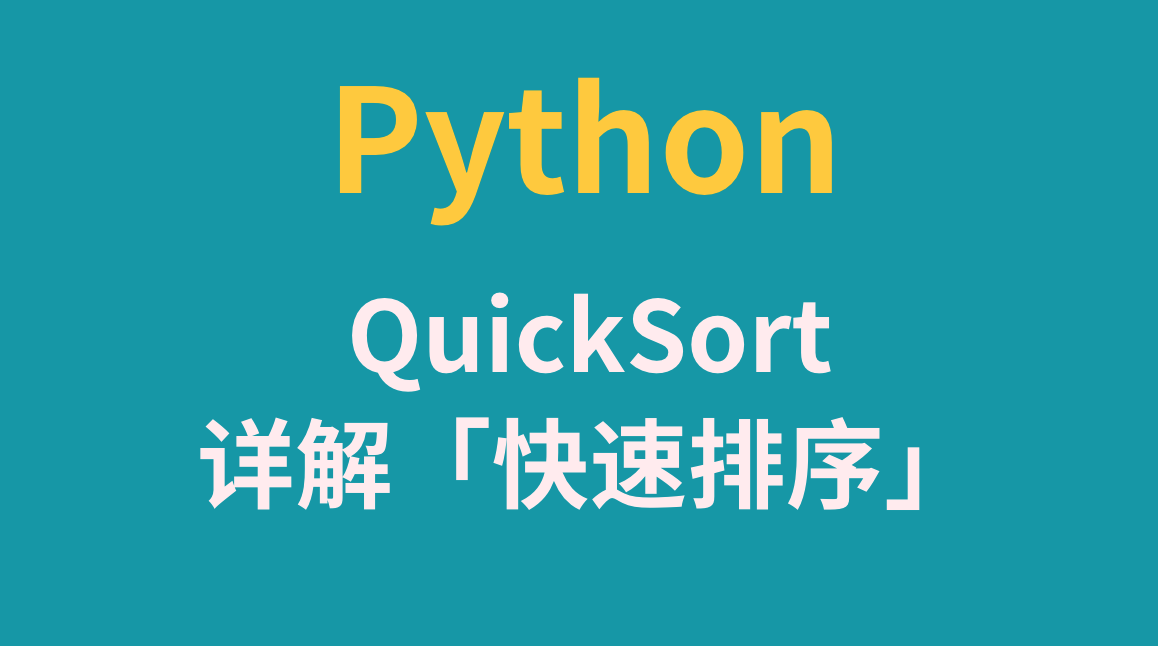
『QuickSort』详解「快速排序」的Python实现
快速排序
快速排序类似于冒泡排序。
主要的思想方法就是选一个基准(pivot),比基准数大的数放在右边,比基准数小的数放在左边。
写出来文字很简单,代码实现起来还是一头雾水的。尤其是引入了2个指针在前后。
这里推荐一篇文章,看完再来看Python的代码实现比较好。
最常用的排序——快速排序
1 我的错误写法
""" 我的错误写法1 我根据定义的写法,把第1个定义成基准值,然后进行对比,向前走,最后交换。 写的什么问题都没有。但其实这里面有个很大的错误。 那就是指针没有进行定义,直接去拿给的参数进行对比。 这样造成的错误就是 while start < end and arr[end] >= pivot: IndexError: list index out of range """ def error_quick_sort(arr, start, end): if start >= end: return pivot = arr[start] while start < end and arr[end] >= pivot: end -= 1 arr[start] = arr[end] while start < end and arr[start] < pivot: start += 1 arr[end] = arr[start] arr[start] = pivot error_quick_sort(arr,start,pivot - 1) error_quick_sort(arr,pivot + 1, end) """ 我的错误写法2 乍一看该定义的也定义了。 但是low和high没有了判断条件就,造成了直接就是排序错误 """ def error_quick_sort(arr, start, end): if start >= end: return pivot = arr[start] low = start high = end while low < high and arr[high] >= pivot: high -= 1 arr[low] = arr[high] while low < high and arr[low] < pivot: low += 1 arr[high] = arr[low] arr[low] = pivot error_quick_sort(arr,start,low - 1) error_quick_sort(arr,high + 1, end) arr = [54,26,93,17,77,31,44,55,20] error_quick_sort(arr,0,len(arr)-1) print(arr) # result # [20, 26, 54, 17, 77, 31, 44, 55, 93]
2 正确实现方法
2-1 思路1
最主要的就是一定要知道各种条件。
递归出口条件是什么?
2个指针什么时候停止?
指针的停止条件是什么?
def quick_sort(arr, start, end): # 递归条件出口 if start >= end: return pivot = arr[start] # 定义前后指针 low = start high = end # 如果前后2个指针不重合 while low < high: # 从后向前走,直到遇到比自己还大的 while low < high and arr[high] >= pivot: high -= 1 arr[low] = arr[high] # 这时候以high为index的位置是空着的 # 从前向后走,直到遇到比自己还小的 while low < high and arr[low] < pivot: low += 1 arr[high] = arr[low] # 这时候high的位置被填充,但low为index位置为空 # 2边这时候都已经无法继续向下走 # 我们把中间这个数值和目前已经为空的以low为index的数值进行交换 arr[low] = pivot # 这时候继续从左边进行递归,每次都缩小1个index的范围 quick_sort(arr,start,low - 1) # 这时候继续从右边边进行递归,每次都增加1个index的范围 quick_sort(arr,high + 1, end) arr = [54,26,93,17,77,31,44,55,20] # end的代指最后一个数值的index,也就是长度-1 quick_sort(arr,0,len(arr)-1) print(arr) # result # [17, 20, 26, 31, 44, 54, 55, 77, 93]
2-2 思路2
这个思路我是参考了Geeks的网站,Python Program for QuickSort
这个思路比较是分为了两个函数。说实话,没大看懂。做一个标记。
有空研究一下。
# Python program for implementation of Quicksort Sort def partition(arr,low,high): i = ( low-1 ) pivot = arr[high] for j in range(low , high): if arr[j] <= pivot: i = i+1 arr[i],arr[j] = arr[j],arr[i] arr[i+1],arr[high] = arr[high],arr[i+1] return ( i+1 ) def quick_sort(arr,low,high): if low < high: pi = partition(arr,low,high) quick_sort(arr, low, pi-1) quick_sort(arr, pi+1, high) arr = [54,26,93,17,77,31,44,55,20] quick_sort(arr,0,len(arr)-1) print(arr) # result # [17, 20, 26, 31, 44, 54, 55, 77, 93]
2-3 思路3(Python列表表达式快速实现)
在网上看到的快速实现,充分发挥了Python和递归思想的优势。
def quick_sort(arr): if len(arr) <= 1: return arr pivot = arr[len(arr) // 2] left = [x for x in arr if x < pivot] middle = [x for x in arr if x == pivot] right = [x for x in arr if x > pivot] return quick_sort(left) + middle + quick_sort(right) arr = [54,26,93,17,77,31,44,55,20] print(quick_sort(arr)) # result # [17, 20, 26, 31, 44, 54, 55, 77, 93]

共有评论(1)
今天面试问了我快排,之前看过动画展示,自己想的类似第三种空间复杂度高的解法。
同样,对第二种解法一眼看下来也是很蒙,换了下写法才理解,两个指针,一个 j 遍历除 pivot 外的所有元素,另一个 i 值变动比较频繁,遍历过程指向第一个大于 pivot 的值(在此之前等于 j),最后跟结尾的 pivot 交换。在遍历过程中,如果 j 小于等于 pivot 就跟 i 交换,以挪到前面。
注意,这样交换是排序不稳定的。
def partition(arr,low,high): i = low pivot = arr[high] for j in range(low , high): if arr[j] <= pivot: arr[i],arr[j] = arr[j],arr[i] i = i+1 arr[i],arr[high] = arr[high],arr[i] return ilthon: